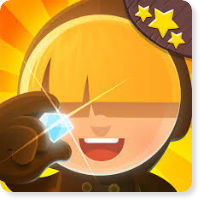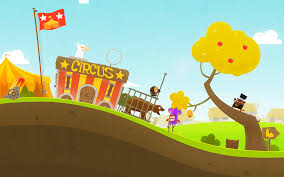Bastion
LQ: 9.15
Recommended Age: 10+
Skills Used: Planning, Working Memory, Mathematics, Reading

Tiny Thief is a point-and-click game where player must guide a lighthearted, heroic petty thief through various stages, helping him obtain specific items and make it to the exit without being caught. Each stage is set up like a puzzle, and players must figure out what actions must be taken to reach items and avoid detection. A set of instructions is available at all times to help guide players through each level, depicting exactly how they should interact with the environment. The directions consist of illustrated examples of each objective, but often take some time to interpret correctly. There will be some instances where players must key in on certain objects like levers, pulleys, and ladder and use them in conjunction with items that they found scattered throughout the level. When the overall puzzle is solved, players can move on to the next level. No reading skills are needed to play, and there is little inappropriate content (the cartoon burglar is akin to Robin Hood), making the game suited for children ages 6 and up.
Teachers: check out the classroom guide!
Developing a systematic approach for setting and achieving goals.

Since each stage require players to complete actions in a specific sequence of steps, the game serves as a fun and simple way for kids to practice short-term planning skills. Players learn how performing a series of smaller steps can help them achieve a larger goal, preparing a route through each level that both gets them the items they need and keeps them from getting caught. If they get stumped, players can always refer to the in-game walkthrough, which gives hints about the correct order in which to perform specific actions.
Because players must always revert back to the illustrated list of step by step clues in an effort to learn to specific way each chronological step should be completed. Players have to interpret and commit some of the steps to memory, especially if they want to maintain a good gameplay flow. While there are on screen prompts near important objects, obvious signs that they should be put to use, Tiny Thief still allows plenty of room for players to make their own mistakes and learn at a pace that's comfortable for them. Players have to interpret a set of directions and apply them directly to the way they choose to move their character through the level. Sometimes it takes players' one or two attempts to learn what not to do for a particular objective. The memorization facet of the working memory thinking skill is less prevalent in Tiny Thief than the application based puzzles that strengthen players' working memory, as they learn important skills in generalization
 Players' should think of each step in the level guide as small goal. Steps generally have to be completed in the order that they are listed, employing a type of scaffolding strategy directly into the way players navigate through the each level. The first level, which takes place both on the deck of a ship and underwater forces players to return to parts of the stage that once seemed useless when then find a particular item. The game guide is not meant to be glanced at. It should be studied. Players should know exactly what they must do every step of the way. Confusion usually leads to back tracking, which only extends the amount of time searching through levels for clues. Attention to detail is key. Once users learn how to apply what they learned in the guide's illustrations they can quickly work through the level. Confusion is also a distraction and can turn players off from continuing play. It's all about being attentive -- actively trying to interpret the game guide without losing sight of the big picture.
Players' should think of each step in the level guide as small goal. Steps generally have to be completed in the order that they are listed, employing a type of scaffolding strategy directly into the way players navigate through the each level. The first level, which takes place both on the deck of a ship and underwater forces players to return to parts of the stage that once seemed useless when then find a particular item. The game guide is not meant to be glanced at. It should be studied. Players should know exactly what they must do every step of the way. Confusion usually leads to back tracking, which only extends the amount of time searching through levels for clues. Attention to detail is key. Once users learn how to apply what they learned in the guide's illustrations they can quickly work through the level. Confusion is also a distraction and can turn players off from continuing play. It's all about being attentive -- actively trying to interpret the game guide without losing sight of the big picture.
All membership plans come with full access to our entire suite of tools learning guides, and resources. Here are a few of the ones we think you’ll like the most: